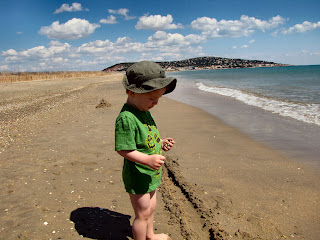We had spent the morning and afternoon in Barcelona , at Park Güell, so our arrival in the French coastal town of Sète
Both restaurants I had taken note of in the Michelin Guide had since publication closed their doors, so we quickly abandoned the vacant Grande Rue Mario Rouston for the supposedly more touristy Quai Général Durand and picked one of the almost empty seafood restaurants facing the water. The food was good, the return to the hotel furtive, and the thought that we might shorten our stay front most in our minds.
 |
| The view from Mont St-Clair to the north over the Thau lagoon |
Sète is at the foot and climbing the slopes of Mont St-Clair, a 541 foot limestone outcrop on the edge of the Thau lagoon. It was once an island, and today is linked to the mainland by two narrow sand spits, the one to the east we had come in on and the other to the southwest that stretches along the Plage de la Corniche, a 7.5 mile long sandy beach and conservation area. There are several canals cutting through the town and the old harbor, Vieux port, which is still used as a port for fishing boats and yachts. The town had caught our attention due to the famous joustes nautiques that take place on the day of St. Louis
The next morning we woke, enjoyed the breakfast buffet at the hotel and ventured out to see if first impressions would be corrected. Daylight made an enormous difference. The streets were filled with people - tourists shopping and strolling, fisherman having returned from the sea, locals with a coffee and paper. It was a different town than we had entered the previous night.
 |
| A fantastic octopus and fountain in a square on our hike |
We set out for a hike up to Mont St-Clair, which is named after a saint who was venerated there sometime in the middle Ages. Once covered by pine forests and oaks, the hill is now swathed with summer houses and high, solid fences. I wouldn’t recommend this steep climb to others; take your car instead. Lacking pedestrian paths and utilizing roads with cars whizzing by around sharp curves, the way up has some nice views but isn’t worth the risk. However the view from the top made the whole stop in Sète worth it! From the esplanade with the large cross that is lit up every night there was a superb view of the town, the Thau lagoon and the coast. (The Bassin de Thau covers 19,768 acres and is the largest lagoon on the Languedoc Pyrenees to the southwest and the Alpilles to the east!
 |
| On our hike down I was ready to jump a fence to get to this pool |
On our descent we stopped at the museum dedicated to Paul Valéry, poet and singer-songwriter born in Sète. While Roberts explored the museum I took advantage of an extremely rare occurrence – both boys were asleep! I parked Lauris in the shade, transferred Mikus from the bjorn to a lounge chair, ordered a café and relaxed with a view of the sea, the town and the cemetery.
The final resting place of Valéry and Jean Vilar, the cliff top cemetery stretches across the side of the hill facing the sparkling Mediterranean with a sea of crosses. We stopped there too before continuing back down to the quay.
Lauris spotted a little tourist train making its way through town, and so we found the tourist office to find out where to hop aboard. The tourist center was helpful with brochures and information, as well as bins of toys Lauris could play with while we organized ourselves. Then, with tickets in hand, we set out on a little train ride around town, informing us of the history and landmarks of Sète.
The town developed in the 17th century, although the harbor, rail lines and maritime canal were developed in the 19th. Today the port ships bulk goods, passengers and containers to North and West Africa, South America, the French Caribbean and Australia
And finally, a stop at the park so that Lauris could expend some of that energy before dinner. As the sun was sinking in the sky, we noticed that the crowds of people were disappearing. Although nowhere as empty as the previous night, on Friday night the phenomenon was repeated; we once again felt very isolated after dark. There is a marked difference between daylight Sète and nighttime Sète.
The following morning we had only two destinations in mind. The first, Parc panoramique des Pierres
Free parking and an empty beach, what more can I ask for? While Lauris and Roberts chased the waves, my hunt for sea glass was on with Mikus dozing in the shade of our umbrella. It was with sand in our hair and salt on our feet that we packed up the car for the last time to head home.
 |
| "I walk the line" |





No comments:
Post a Comment